The sun has at last forced its way through the dense cloud cover, and beams of afternoon light stream across the workshop. The radio is competing with the cacophony of the looms as the weavers collide the wooden panels together. The women are sitting on cushions on the floor, their backstraps pulling their threads tight. One is using a porcupine quill to expertly feed the cotton across the loom.
I have journeyed in beat-up minivans on mostly unpaved roads to the town of Hakha in the heart of the remote Chin Hills in western Myanmar. Every journey has been preceded by a prayer, as the local Chin population is devoutly Christian. But it is the dry season and the vans weaved without incident, around the mountains and into the clouds. As we travelled through huge swathes of hillsides, void of any sort of settlements, I marvelled at the rich forest cover, only occasionally broken by small areas of cultivation. Motorbikes carrying men clutching lengthy shotguns were the only other traffic on the dirt tracks.
Nazareth, my first driver, tells me that here most people live hand-to-mouth, surviving from hunting animals such as deer and buffalo, and growing vegetables. Indeed, Chin State is one of the poorest and least developed states in Myanmar, consistently topping poverty indicators. Until a ceasefire in 2012, these hills were home to one of Myanmar’s armed insurgency groups who claimed to be fighting for the well-being of their people. As I pass through tiny villages of ramshackle buildings lacking even the most basic services, it is not hard to see how this could have arisen.
Perhaps it is due to the Chins’ geographical isolation that the tradition of backstrap weaving has survived. Chin women are reputed across the country for their skilled weaving of intricate designs using this indigenous technique. While a handful of international dealers in Yangon curate selections of the highest quality pieces, the onslaught of cheap imports from China and India has meant homemade Chin fabrics have all but disappeared from the domestic market for traditional clothing.
I break my journey to Hakha in Falam, a mountain town of colorful, wooden houses perched on stilts, and Nazareth’s home. He promptly pushes open the unlocked door of a nondescript building and introduces me to Mrs. Run Mawi, Falam’s master weaver, and her daughter, Razel. They are sitting in the dim light in front of looms strung with red, green, purply-blue, and golden yellow—the traditional colors of Falam clothing.
Both are making the traditional cawng nak, a wide sash made to cover a man’s torso diagonally, from shoulder to waist. It takes two months to make one cawng nak, and Chin customers, now living abroad, often order a year in advance. Weaving, they tell me, is the main source of income for this family. I ask Mrs. Mawi if she’s proud of her work.
“Yes, when I weave I am happy,” she says. “Why would I want to do anything else?”
I wander around Falam and meet a few other weavers with their looms set up on their porches and in their doorways. They shyly tell me they are only weaving for friends and family, and it appears Mrs. Run Mawi’s operation is perhaps the exception. I have read that compared to 30 or 40 years ago, very few women know how to weave and the tradition is gradually disappearing. Razel agrees as she tells me most women now buy clothes that come from factories in the plains of Myanmar—made with machine looms in a fraction of the time, at a fraction of the price.
The Chin Hills rise steeply out of the plains of central Myanmar and catch errant clouds that float in from the east. The morning I leave Falam, the town is again enshrouded in mist. As we bump along the windy road to Hakha, it occasionally lifts and I catch glimpses of far-away hamlets down the steep valley sides.
Arriving in Hakha, I hurry to my hotel just as the first heavy raindrops fall. Eager to meet Anna, I brave the storm and scale the steep pathway to her workshop. Anna Biak Tha Mawi is a social entrepreneur who is reviving demand for backstrap weaving through contemporary versions of traditional Chin outfits. Born in Chin State, 29 year-old Anna spent most of her life in Yangon, returning to the area only relatively recently for research as a film student. It was during this time she started to appreciate the extent of the poverty in the region, but yet the underutilization of local skills. She began working with local weavers to produce new designs for herself and friends and quickly realized that through social media, these skills could be linked to demand for high-quality clothing from more affluent Chin communities living abroad and in other areas in Myanmar.
In 2012, she set up Aidii Collections which now employs more than 40 female weavers producing a mixture of traditional and modern Chin outfits, the majority of whom are working from their homes in remote villages.
“They are mothers and housewives, some of whom have been weaving for over 20 years,” Anna explains. “But generally, they cannot leave their homes, and have no reliable customer base.”
Historically, the Chin people belonged to a patchwork of different tribes and conservative tribal customs have shaped attitudes towards women. In the past, a groom’s family was expected to pay a ‘price’ for the bride, objectifying women. Rarely allowed to leave their houses, females have historically had few opportunities to independently generate an income and little control of the family’s finances. Attitudes are changing, but, particularly in rural areas, significant change takes time. Anna’s model acknowledges the reality of the lives of many women in this region, while bringing a modest, but important income into their hands.
While her main aim is to generate livelihoods, Anna is also striving to create a sense of value and pride around the skill of weaving. Changing perceptions, she hopes, will help to halt the decline of backstrap weaving in this part of Myanmar.
“Chin people do not see weaving as professional work; only government, company or NGO jobs are seen as sustainable options for their children’s future,” she explains. “Local customers are rarely willing to pay the price of the garments, even though they are aware of how difficult and time-consuming the textiles are to weave. So weavers do not see a market for their products.”
By providing these communities with a reliable marketplace, she hopes Aidii weavers are beginning to believe they can make a living from weaving, and are drawing a sense of pride from their work. She plans to take them to the country’s bigger cities to show them larger marketplaces and how buyers value garments.
“Seeing is believing,” she says. “Most of these women have never left Chin State, and right now they don’t understand my vision.”
Before I leave I ask Anna what she thinks is the biggest challenge facing the Chin people. Quickly, she replies, “We are always looking for help from outside, from abroad. We used to make so many things, but now we just buy everything from outside. We don’t recognize our resources here. Chin ladies are famed for weaving, yet most clothes being sold here are not made in Chin State. This was the inspiration for Aidii.”
As my minivan swerves down the mountains to the warmth of the plains, I ponder the future of indigenous production techniques such as these, not just in Myanmar, but globally. It feels a great deal will depend on the attitudes and lifestyle aspirations of the young. While Mrs. Run Mawi happily sits at home weaving daily, Razel chatters to me about her plans to return to Singapore to work as a caretaker for elderly Chinese. The city is exciting she says, her eyes glistening.
But ultimately, whether this skill and form of art can survive the talons of globalization will surely depend on what kinds of products are demanded by consumers. Across the world, buyers are waking up to the human and environmental costs of cheap garment production, but this is yet to translate to significant change through action. Enough people must be prepared to pay a higher price for quality, ethically made products to ensure they continue to be produced.
“It is about education—of both the weavers and customers,” Anna says. “We have to tell a story about these products—how we produce, how difficult the process is. We need to appreciate the cultural value of the skill.”




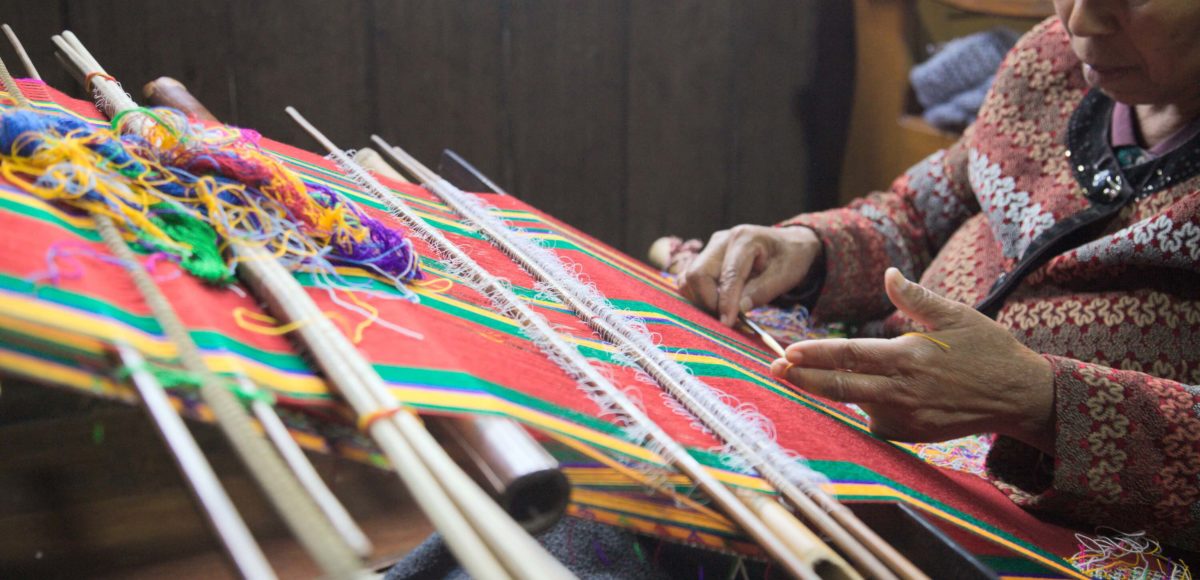

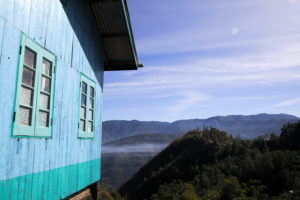
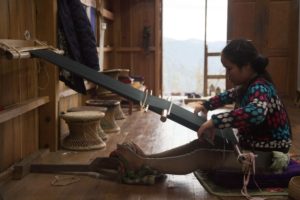
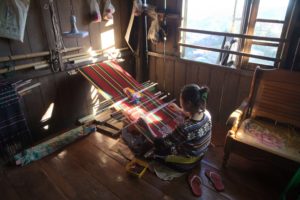
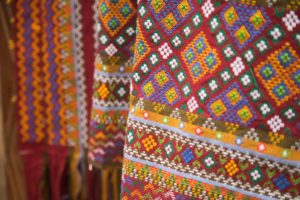
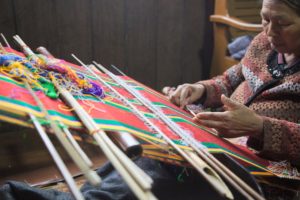
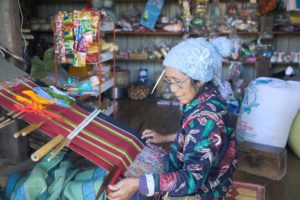
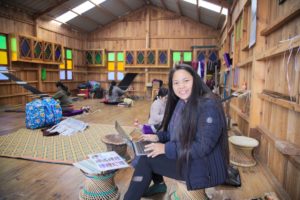
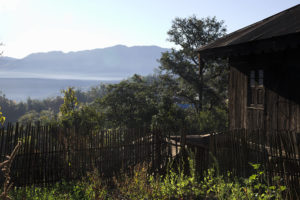




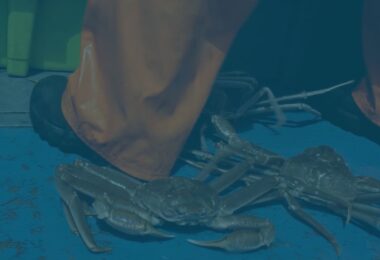

No comments